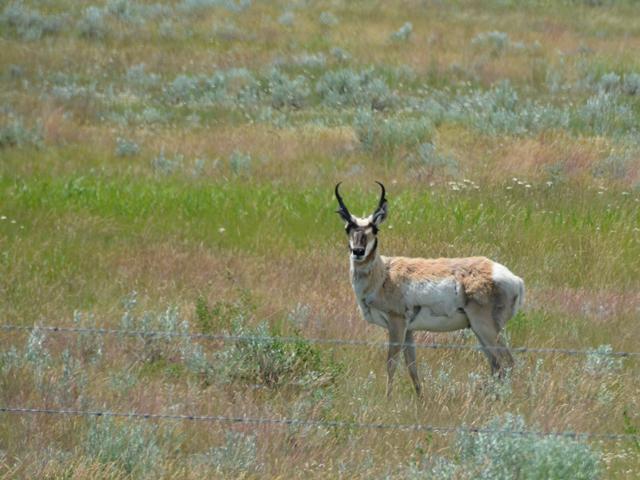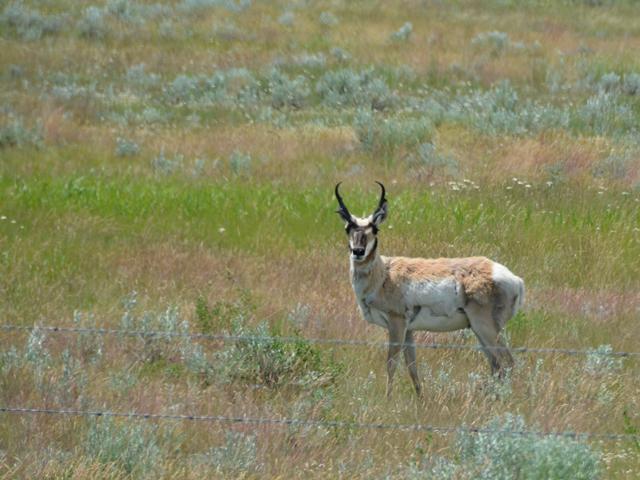Ag Policy Blog
USDA Expands Working Lands for Wildlife Initiatives
Western livestock producers and landowners will have more opportunities to get compensated for migratory big-game animals that graze on their lands under one of the new conservation funding programs USDA rolled out Tuesday.
USDA announced it will spend $500 million over the next five years to promote wildlife conservation on working lands. Part of that initiative for producers will be to tie the Conservation Reserve Program (CRP) into USDA's Working Lands for Wildlife (WLFW) programs. The announcement essentially brings together USDA's alphabet soup of conservation programs in various ways to compensate producers for wildlife habitat.
In Western states, at least $40 million through the Environmental Quality Incentives Program (EQIP) and the Agricultural Conservation Easement Program (ACEP) will help conserve migratory big game habitat by taking a pilot program stated in Wyoming and expanding it to Idaho and Montana.
Lesli Allison, chief executive for the Western Landowners Alliance, told DTN the wildlife habitat programs, including those for big-game migration, are providing a new model for conservation efforts on working ranches.
"If you have got elk eating so much of your pasture that you are having to lower your stocking levels, maybe we can get some compensation for that to allow you to manage for those things," Allison said.
Wyoming has been a pilot for these efforts in recent years, allowing ranchers to stack different programs such as the Environmental Quality Incentives Program (EQIP) and easement or Conservation Reserve Program. State and private groups can then chip in to help fill the gaps in those USDA programs.
P[L1] D[0x0] M[300x250] OOP[F] ADUNIT[] T[]
"They are going to build on the Wyoming pilot and expand it into Montana and Idaho," Allison said. "It's an all-hands-on-deck effort that starts with helping the working lands that support wildlife, and that's why it's been so popular. It's been supported strongly by the livestock industry, but also the state and environmental groups."
Allison said a key change is blending the Grasslands CRP into the Working Lands for Wildlife Framework. The Grasslands CRP allows a producer to continue grazing their ground but provides some compensation for the wildlife habitat. Enrollment in the Grasslands CRP has taken off in popularity in recent years. Under the new initiative, EQIP and ACEP could be tied in with the Grasslands CRP as well.
"They are trying really hard to not make this a top-down program, but just make the resources available for what the locals want to see happen," Allison said.
The joining of programs means USDA's Natural Resources Conservation Service (NRCS) and Farm Service Agency (FSA) will coordinate the work through Working Lands for Wildlife. Nationally, the new funding provides $250 million in ACEP and $250 million for EQIP that will be tied to the Working Lands for Wildlife efforts.?
Robert Bonnie, USDA's undersecretary for Farm Production and Conservation, briefed state leaders Tuesday at the Western Governors Association meeting in Boulder, Colorado.
"When you find a conservation approach that works, double down -- and that's what we're doing with Working Lands for Wildlife," Bonnie said. "America's farmers, ranchers, forest owners and tribes steward the majority of our nation's wildlife habitat, and our work with them has yielded enormous gains for sage grouse, longleaf pine, and other species and ecosystems. Working Lands for Wildlife is ready to go to the next level, and today's incorporation of the Conservation Reserve Program into its vision is a major leap forward. We pledge to keep building the policy, funding, and human capacity to deliver large-scale, working-lands conservation well into the future."
USDA noted the wildlife initiative ties into the department's efforts to implement the $19.5 billion USDA received under the Inflation Reduction Act for conservation programs. Those efforts have a caveat that the funds must go to reduce carbon emissions or sequester carbon. USDA stated in its news release that "wildlife habitat conservation in forests, grasslands and sagebrush can also provide important carbon storage opportunities and climate-mitigation benefits."
Among some of the other efforts tied to Tuesday's announcement, 25 Central and Eastern U.S. states will have $14 million in new EQIP funding dedicated to conservation of bobwhite quail and associated species in the grasslands and prairies in the central and eastern U.S. Also, IRA funding will build outcomes for Northern bobwhite recovery, as over 3.5 million acres will help mitigate greenhouse gases.
Another aspect of the Working Lands for Wildlife effort will be $30 million that will go to partner groups to add staff that will help USDA provide technical assistance. USDA also added that it will help NRCS' efforts to hire more staff as well to "increase boots on the ground to assist producers, states, tribes and other partners to meet their climate and conservation goals."
The Wildlife for Working Lands framework, started in 2010, has worked with 8,400 producers across nearly 12 million acres nationally. In Western states, the program has identified challenges to the sagebrush and Plains states grasslands, which are facing more pressure from residential development, cropland conversion, invasive species, and woodland encroachment across an area the size of 11.5 million acres -- an area five times the size of Yellowstone. The framework is an effort to help landowners keep their land intact while supporting wildlife as well.
Similarly, the northern Bobwhite, Grasslands, and Savannas framework identified woodland encroachment, loss of prescribed burning, and climate change as major threats, and WLFW set a goal of 7 million acres by 2027 across 25 central and eastern states, USDA stated.
For more details, go to https://www.nrcs.usda.gov/….
Chris Clayton can be reached at Chris.Clayton@dtn.com
Follow him on Twitter @ChrisClaytonDTN
(c) Copyright 2023 DTN, LLC. All rights reserved.






Comments
To comment, please Log In or Join our Community .